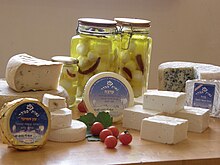Our website is made possible by displaying online advertisements to our visitors.
Please consider supporting us by disabling your ad blocker.
Animal product


An animal product is any material derived from the body of a non-human animal or their excretions.[1] Examples are meat, fat, blood, milk, eggs, honey, and lesser known products, such as isinglass, rennet, and cochineal.[2]
The word animals includes all species in the biological kingdom Animalia, except humans. This includes, for example, tetrapods, arthropods, and mollusks. Generally, products made from decomposed animals, such as petroleum, or crops grown in soil fertilized with animal remains or manure are not characterized as animal products. Products sourced from humans (e.g. breast milk) are not typically classified as animal products.
Increased production and consumption over the past 50 years has led to widespread environmental and animal welfare impacts. These range from being linked to 80% of Amazonian deforestation[3] to the welfare implications of using chick culling shredders on live day old-chicks for 7 billion of them each year.[4]
Several popular diet patterns prohibit the inclusion of some categories of animal products and may also limit the conditions of when other animal products may be permitted. This includes but not limited to secular diets; like, vegetarian, pescetarian, and paleolithic diets, as well as religious diets, such as kosher, halal, mahayana, macrobiotic, and sattvic diets. Other diets, such as vegan-vegetarian diets and all its subsets exclude any material of animal origin.[5] Scholarly, the term animal source foods (ASFs) has been used to refer to these animal products and by-products collectively.[6]
In international trade legislation, the terminology products of animal origin (POAO) is used for referring to foods and goods that are derived from animals or have close relation to them.[7]
- ^ Gilman, Daniel Coit; Peck, Harry Thurston; Colby, Frank Moore (1907). The New International Encyclopædia. Dodd, Mead & Co. p. 474.
- ^ Unklesbay, Nan. World Food and You. Routledge, 1992, p. 179ff.
- ^ Skidmore, Marin Elisabeth; Moffette, Fanny; Rausch, Lisa; Christie, Matthew; Munger, Jacob; Gibbs, Holly K. (April 2021). "Cattle ranchers and deforestation in the Brazilian Amazon: Production, location, and policies". Global Environmental Change. 68: 102280. Bibcode:2021GEC....6802280S. doi:10.1016/j.gloenvcha.2021.102280. ISSN 0959-3780.
- ^ Krautwald-Junghanns, M-E; Cramer, K; Fischer, B; Förster, A; Galli, R; Kremer, F; Mapesa, E U; Meissner, S; Preisinger, R; Preusse, G; Schnabel, C; Steiner, G; Bartels, T (November 17, 2017). "Current approaches to avoid the culling of day-old male chicks in the layer industry, with special reference to spectroscopic methods". Poultry Science. 97 (3): 749–757. doi:10.3382/ps/pex389. ISSN 0032-5791. PMID 29294120.
- ^ Stepaniak, Joanne. Being Vegan: Living with Conscience, Conviction, and Compassion. McGraw-Hill Professional, 2000, p. 7.
- ^ Adesogan, Adegbola (October 14, 2019). "Animal source foods: Sustainability problem or malnutrition and sustainability solution? Perspective matters". Global Food Security. 25: 100325. doi:10.1016/j.gfs.2019.100325.
- ^ "Animals and animal products: international trade regulations". Archived from the original on January 14, 2021. Retrieved August 6, 2018.
Previous Page Next Page


